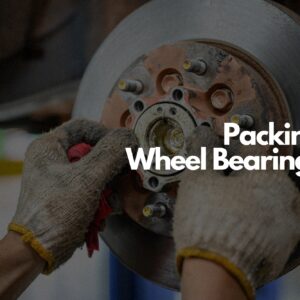Trailer bearings are essential because they support your trailer’s weight and allow the wheels to rotate freely. However, like any other bearing, trailer bearings need maintenance so that they don’t cause problems. We’ll talk about the importance of servicing trailer bearings, the common signs of dry bearings, and provide tips to keep your trailer bearings running smoothly.
What Are Trailer Wheel Bearings?
Trailers have roller bearings in their wheel hubs resting on spindles like the front wheels of a car or pickup used to have in the ‘70s and ‘80s. These bearings support the trailer’s weight and allow the wheel to spin freely. Like any other bearing, trailer bearings comprise an inner and outer ring with metal balls or rollers in between.
Why Trailer Bearings Need To Be Serviced
Over time, the grease inside a trailer bearing will dry out. When this happens, the bearing needs to be serviced. Servicing or repacking a bearing involves reapplying grease to its internal components, particularly the race and metal balls.
The grease serves several functions. Firstly, grease lubricates the bearings and protects the metal components from rust. Grease also absorbs shock and vibration, which reduces stress on the bearings. The grease can help dissipate the heat generated in the bearings as they rapidly spin. Lastly, thick grease helps prevent water and other contaminants from entering the bearing and damaging the rollers or races. Grease is even more important if you have a boat trailer since its wheels are going to be submerged in water when launching the boat.
Dry Bearing Symptoms
If a trailer bearing has dried up grease, it can show symptoms such as:
- Squealing or grinding noises.
- A hot wheel hub.
- Unusual vibration or wobbling from the wheel.
- It can get hot and catch fire while driving (this happens more than you think)
If a trailer bearing isn’t serviced, the bearing can seize, which will prevent the wheel from spinning freely. The inner and outer bearing races can come apart in a worst-case scenario. This can cause the wheel to come apart while you’re on the road. The spindle or axle can also get damaged, warranting an expensive replacement.
Tips on How to Grease Bearings on a Trailer
Get Grease Specifically Made for Bearings
There are different types of grease with various viscosities. Each grease type can have an ideal temperature, speed, and load. You’ll need trailer wheel bearing grease because it’s formulated for the conditions inside a trailer bearing. If you have a boat trailer, you’ll need marine-specific bearing grease because marine bearings are intended to be submerged.
Lift Your Vehicle From the Ground
You’ll need to raise the trailer using the jack and jack stands. At the same time, you must chock the wheels to ensure the trailer doesn’t move while you’re working on it.
You’ll also need clean rags to clean grease off surfaces and gloves to protect your skin from the grease.
Spin the Wheel When Pumping the New Grease
Some marine trailers will have wheel hubs that have a grease fitting. This will allow you to pump fresh grease into the bearing without taking the wheel hub apart. Pumping grease into the bearings involves inserting a grease gun into the port. Once you begin pumping, the new grease will push the old grease out the front.
You must spin the wheels during this process so the new grease gets into every nook and cranny. Eventually, you’ll notice that the grease getting pushed out is clean. This is the sign to stop. Afterward, wipe the excess grease, pull the grease gun hose from the port, and reinstall the dust cover.
Replace the Bearing Seals
Some trailers will have a bearing seal that can wear out, which can cause them to lose grease. These trailers typically don’t have grease ports, so you can only access the wheel bearing with the wheel removed. You’ll only see the bearing dust cap after you’ve removed the wheel.
As mentioned previously, you can remove the dust cap with a screwdriver. Once removed, the cotter key or pin will be visible. You’ll need to straighten out the pin and pull it out using a pair of needle-nose pliers.
Once the pin is removed, you can unscrew the spindle nut and expose the bearing. Pull the wheel hub and catch the bearing as it falls out. The bearing will likely also have a washer attached to it.
Remove the wheel hub and you’ll see the inner bearing and seal still attached at the back of the wheel hub. If the exterior part of the seal is wet, then the seal is compromised and you’re losing grease. You’ll need to replace the bearing seal after every service.
Inspect the Bearings
You can remove the inner bearing with a screwdriver to pry it out of the wheel hub. Now, you’ll have the entire bearing removed. You’ll need to submerge the bearings and spindle nut in kerosene or acetone to clean the bearing parts completely and remove all the old grease. You should use a clean rag to remove any stubborn grease that remains. Once cleaned, look for scratches, pitting, or discoloration on the bearing. If the bearing is damaged, then you’ll need to replace it. If the bearing is in good condition, thoroughly coat the bearing’s exterior with new grease and reinstall the bearing on your wheel hub.
It’s important to keep your trailer bearings properly greased to keep your trailer rolling safely. You can effectively grease your bearings as long as you follow the tips in this article. Remember to inspect your bearings regularly for damage and replace any worn-out parts when necessary to avoid safety hazards.
Where to Get High-Quality Bearings for Your Vehicle
As mentioned, it’s important to service a dry trailer bearing. Vehicles have different bearings installed. Be sure to have yours inspected and replaced if needed. Thankfully, CarParts.com has high-quality replacements.
We can guarantee the quality of our bearings because we source them from the most trusted manufacturers in the industry. This ensures you get long-lasting replacements. We also offer them at different price points, so you’re sure to find ones that match your budget. If you have questions, don’t hesitate to contact our customer service representatives. Our team is available 24/7 via our toll-free hotline.
Shop now at CarParts.com to get the best deals on bearings today!
Any information provided on this Website is for informational purposes only and is not intended to replace consultation with a professional mechanic. The accuracy and timeliness of the information may change from the time of publication.

































